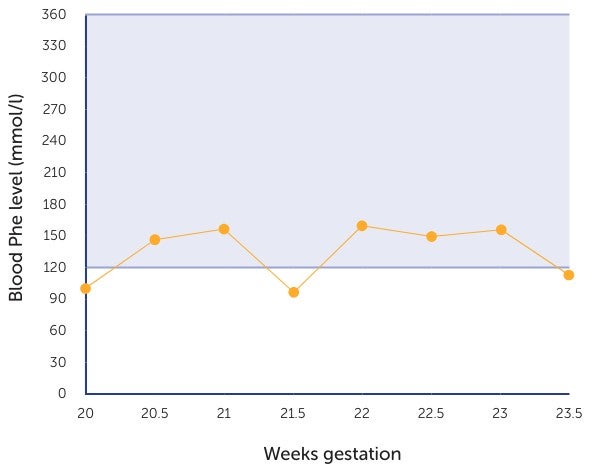PKU sphere™: Use in Pregnancy | Case Study
Description
A case study on the use of PKU sphere™ as a protein substitute during an unplanned pregnancy.
Notes:
PKU sphere is a Food for Special Medical Purposes
Age: 30
Gender: Female
Diagnosis: Phenylketonuria (PKU) via new born screening
Relevant history: One previous pregnancy; a 2 year old daughter (non PKU) who is growing and developing well. Both the current and previous pregnancies were unplanned.
Relevant medical history:
Presented November 2016 with a positive pregnancy test, estimating she was around 6 weeks pregnant. Prior to presentation, the patient was following a relaxed PKU diet (self-restricting natural protein but no protein substitute); blood Phenylalanine (Phe) varied between 900-1000 µmol/L. (Pre-conception and pregnancy target phe = 120-360 µmol/L)[1]
Recommended usual protein substitute (amino acid (AA) based, ready to drink) - 60g PE/ day. Protein exchanges reduced to 0 to rapidly reduce blood Phe to desired levels of 120-360 µmol/L.
At week 20, and on 17 protein exchanges per day, it was apparent that the patient was struggling to take her full prescribed dose of protein substitute (60g PE/day). Patient was complaining of nausea, sickness and stomach pain.
Patient was asked by dietitian to try PKU sphere, a new glycomacropeptide (GMP)-based protein substitute. Patient preferred taste of GMP-based product, resulting in improved tolerance of protein substitute. Prescription and home delivery of PKU sphere organised.
The product guidelines for PKU sphere recommend that it is introduced cautiously and under careful supervision during pregnancy, due to its Phe content (36mg/20g PE). [2]
Start

Prescribed 3 x AA-based protein substitutes per day (60g PE)
Baseline Phe levels- 100-143 µmol/L
Step 1 - Week 21 gestation

1 x PKU sphere20 (20g PE, 36mg Phe)
2 x AA based protein substitutes per day (40g PE)
Blood Phe levels checked twice weekly:
Blood sample 1: 153 µmol/L - no further changes made
Blood sample 2: 96 µmol/L - protein exchanges increased by 1 (Total: 18 exchanges/day)
Step 2 - Week 22 gestation

To increase PKU sphere20 to b.d (40g PE, 72mg Phe)
Reduce AA based protein substitute to o.d. (20g PE)
Blood sample 1: 159 µmol/L - no further changes made
Blood sample 2: 150 µmol/L - no further changes made
Step 3 - Week 23 gestation

PKU sphere20 increased to t.d.s. (60g PE, 108mg Phe)
Blood sample 1: 156 µmol/L - no changes made
Blood sample 2: 112 µmol/L - protein exchanges increased by 2 (Total: 20 exchanges/day)

Due to the poor tolerance of her AA-based protein substitute the patient requested an immediate switch to PKU sphere. A compromise was made to increase by one PKU sphere20 per week, whilst still closely monitoring tolerance and Phe levels, with twice weekly blood samples.
Fortunately, this worked well with the patient being very compliant with both her blood sampling and dietary regimens. High Phe levels were not observed - see graph on left.
The patient continued with PKU sphere for the rest of her pregnancy and gave birth to a healthy baby boy. As she tolerated it so well, compared to her previous AA-based protein substitute, she plans to carry on using PKU sphere as her protein substitute post pregnancy, ensuring her protein requirements are met.
This experience showed that PKU sphere may be well tolerated during pregnancy and for this lady it certainly reduced her feelings of nausea and sickness which meant she had no problem with taking her full dose of protein substitute.
This improved tolerance, compared to her previous protein substitute, was a huge relief for this individual. Not being able to take her full dose of protein substitute was causing her much anxiety during pregnancy and finding a substitute she enjoyed helped her relax about her diet and enjoy her pregnancy.
Furthermore, it showed PKU sphere can be introduced relatively quickly without affecting phe levels. During the 3-week introduction, despite the additional dietary Phe supplied by PKU Sphere and an increase in natural protein intake, metabolic control was not compromised.
This helped make the diet more achievable and varied, enabling full compliance.
- Van Spronsen FJ, van Wegberg AM, Ahring K, Bélanger-Quintana A, Blau N, Bosch AM, et al. Key European guidelines for the diagnosis and management of patients with phenylketonuria. The Lancet Diabetes & Endocrinology. 2017.
- Vitaflo dietitians in collaboration with MacDonald. A and Daly A. The introduction and use of PKU sphere, a Glycomacropeptide (GMP) based protein substitute, in children and adults with PKU. 2017.


